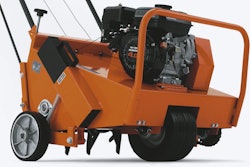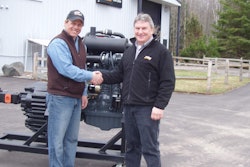WHY: Drip irrigation can be used almost anywhere spray, rotary or impact sprinklers are used, but on-surface drip systems are becoming increasingly popular for bedding areas because they take less time to install and offer significant water savings. On-surface drip can be adapted to any planting configuration and is ideal for areas such as side strips, medians, narrow walkways or decorative channels.
“It’s important for the contractor to understand the fundamentals of hydraulics based on past spray and rotary experience,” says Mark Hall, district sales manager of Netafim USA. “If not, various training is available via classroom, field or with online tools.”
Selling an on-surface system has particular advantages in drought-prone areas because it conserves water and may be exempt from watering restrictions and bans. “We typically realize about a 30 percent savings in efficiency with our installations,” says Eric Jencks, president of Viridian, a San Diego-based design/build firm. “And maintenance and repair costs are far less compared to spray installations.”
Although the example shown here would suit a small area, the basics are the same for larger installations.
1. Connect to the water source. “Drip irrigation can be connected to a faucet or an above- or below-ground PVC main lateral,” Hall says.
2. Connect the system to a backflow prevention device (check local codes for requirements). Install a valve, filter and pressure regulator kit for the tubing.
TIPS
1. To make handling the tubing easier, Jencks recommends using a wheel barrel distributor available from Netafim. “It expedites the process and keeps the tubing out of planting areas.”
2. “To save time for the installation crews, we cut a couple of pieces of PVC pipe to serve as pre-measured ‘yard- sticks’ for spacing rows and so on,” Jencks says.
3. Connect standard or battery-operated controller.
4. Lay out drip tubing in a loop pattern.
• Use fittings to add rows.
• Space rows evenly 1 foot to 1 ½ feet apart.
• Tubing can be looped around large plants.
• Keep outside rows about 2 inches to 4 inches away from edges of hardscape.
5. Use staples to secure tubing. Staples should be used every 3 to 5 feet to secure the tubing to the ground.
Material Sources:
Netafim and Rain Bird are the two major players in the dripline irrigation business. Learn more at netafimusa.com and rainbird.com
6. Install a manual flush valve. At the location farthest from the water source and about middle of the loop, add a line-flushing valve. Turn on the system, open the valve and run until water appears clean.
7. After all connections have been tested, cover the tubing with mulch, gravel or ground cover.
PAYOFF: Drip tubing irrigates the landscape with a slow and steady application of water to the root zone, which helps plants mature faster and saves water. It also eliminates overspray damage to the hardscape, fences, home and building facades.









